Finally bit the bullet and bought a TIG welder


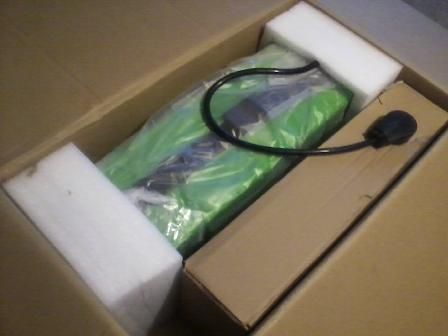
Got it in one piece and everything is better quality than I expected. Nice, solid brass connectors, the whip of the torch came with a zip up cloth sleeve to keep it in good shape, came with some 1/4" ID braded clear PVC line to connect the gas with, owners manual with exploded views of everything, basic operation instructions, an extra lug on the back of the machine for a secondary ground that you can run out to a stake, ball bearing flow meter regulator, calibrated for argon and no clamp for a stick electrode (which I could care less about).
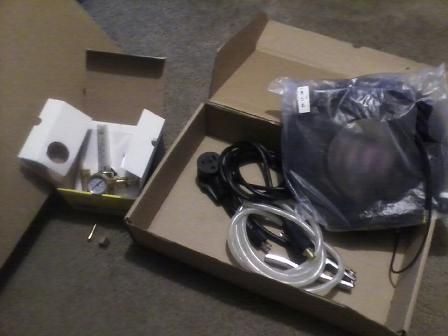
I'm still not out of the woods, though. I had to purchase a few things to get this tool as usable as I'd ultimately like it to be.
Reluctantly, I traded in my empty Oxygen and Acetylene tanks at the gas shop, for a full tank of 100% Argon and a half tank of Helium.
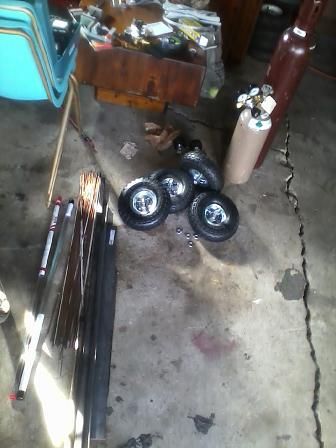
I have a nice set of Vector torches, with three different sizes, a rosebud and a cutting torch that I used for a few things here and there, but I won't be needing them until I start doing panel beating on aluminum or bending a few things. It's still the best way to weld aluminum, if you are going to planish the weld out, because distortion isn't relevant and even heating/ annealing is a must. formed aluminum without annealing will bend once. Bend it twice and it snaps or becomes extremely brittle at best.
I was going to get new cylinders and keep them around for my torches, but I can't afford it. The gas shop wants $250ish a piece for their cylinders, plus fill. Spent $35 each on matching regulators and a few bucks on some brass barb fittings with a T fitting to Y them together. I was going to put residual valves on them, but I don't really care if I get a little mixing at the tanks, when I do go from mixed to all argon or back.
Most people go with all argon for most projects. I will, just the same. It works great, until you start messing with dirty cast or thick aluminum that requires extra shielding. The arc goes through less atmosphere and becomes hotter, requiring less energy to produce the same weld, so it takes load off of welding any aluminum thicker than .065" or 1/8". It's also ideal for cleaner looking welds, from the added shielding properties. It also helps on this machine, which has a max amp rating of 185, so potentially, I can carry it beyond a 185 capacity with helium in some places.
The way this thing welds puts a smile on my face, but it is definitely not a MIG. lol.
I discovered quickly that it is picky. You do not weld dirty metal, you pay attention to angle, tip distance and you do not weld outside if you can help it.
I also quickly discovered that if you contaminate the tip (touch it once to the metal you are welding) that it welds like crap. Like, turning off the gas on a MIG. It's that drastic. So, when you are learning, you will be sharpening the tungsten tips to decontaminate them more than you will be welding.
Eventually, I got the hang of it, after some practice on cleaned junk stainless sheet that I had and ran a bead on the square frame steel, for the base of my welding cart.
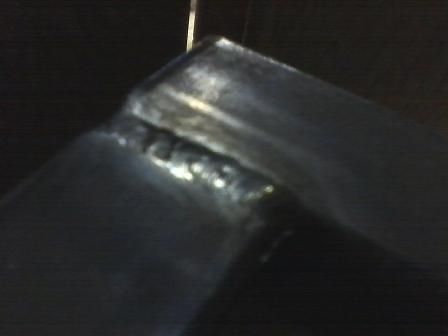
I also learned that not having a foot pedal kind of sucks for anything, other than really basic welding.
This welder came with a hand switch torch. This gives the set amp/ heat on the machine dial at full on/ off. There is no taper. This feature is awesome for odd positions. I can see it coming in handy for tac welding parts into position (stuff like header/ exhaust and intake/ turbo mandrel bending) to then remove and place in easy access to do a more controlled weld.
When I looked at the welder and read reviews, everything about it was awesome, except for the pedal. Quite honestly, it did look kind of janky. The axis rocks in the center of the foot pad, making it awkward, unlike a gas pedal or sewing machine that pivots at the heel.

I also discovered that any halfway decent pedal is no less than $150. I then discovered that people are making them out of things, like guitar flanger pedals. They are extremely simple. They utilize a rack gear that moves up and down with the toe of the pedal and a circular potentiometer down low, on a gear. Some of them work on 47k and some of the good ones with better increments work on a 50k ohm, linear gain. You don't want a ramped gain.
[ame="http://www.youtube.com/watch?v=iq93Y8m2yb4"]Harbor Freight Tig Welder Foot Pedal - YouTube[/ame]
The first bit shows how the pedal has helped his welding.
5:38 shows the pedal and it's mechanisms.
So, I spent about $35 total, including a stainless rack and gear and I'm going to make my own, with a chrome foot gas pedal, 'cause why the hell not?



I didn't know this, going into this Everlast welder, but the home site has an active welding forum, moderated by Everlast employees who listen to the member's suggestions on new products, prototyping and overall support of their products. I was able to fish around on the site and get a pinout for the 7 pin connector, to run the 3 leads from the potentiometer to the machine, and the part number for the bulkhead and pins.
The 2nd potentiometer that I bought will be mounted on the side of the pedal, for overall sensitivity adjustment, which I will want for different jobs. It can also act as an amp limiter, so I can set final values on full pedal, if I don't feel like guessing.
There were times when I was welding with it, that I wished I could have backed the amperage down. As you heat soak the part, it becomes easier to flow the weld bead. If you've ever soldered with a torch or gas welded, this is very similar, only more controlled.
The cart that I'm building will also double as a welding table, with a drawer to hold different gas lenses, tungsten, my pedal, hooks for the lines, a dedicated tungsten grinder with a diamond wheel (they demolish grinding wheels too quickly) and a host of basic welding clamps.
The auto dimming lens arrived from China. The moron sent me a different, non adjusting one that has no battery power. It's solar activated and powered, and stuck at #9 shade, which is entirely too bright.
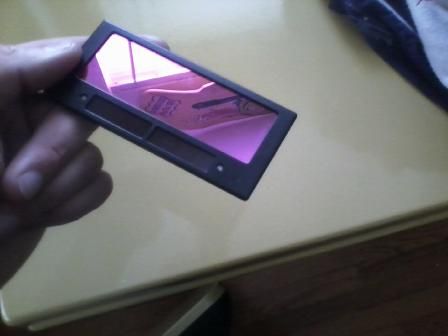
So, I'm still looking for a local supplier for an adjustable lens with battery power, for less than $50 if I can help it. I can get an entire helmet for $40, but I'd rather update mine.
I've been using my friends for the time being, which works half of the time. TIG welding is a joke without auto darken, because you double your chances of touching the tungsten to the metal, meaning you stop everything and clean it up.
I'll have more pics as I complete the cart. I'm using a stainless BBQ that is shot for metal.
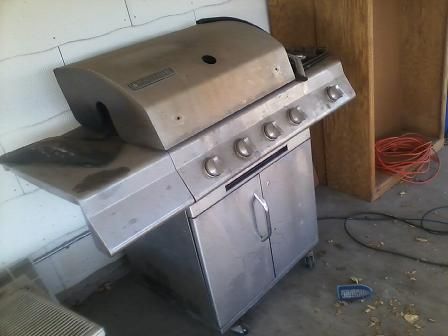
It was laying on the ground, on it's side, behind my work. They were going to throw it in the dumpster. It is repairable, I have the handle and everything else, but I like my charcoal BBQ more and it's worth more to me as usable stainless sheet than a spare grill. I'm also going to take the burner, propane fixture and grilles out to make a wood steaming box and boiler for it, to do some bent wood furniture and other parts (steering wheel, replacement woody fender arches for a friend's Plymouth, etc).



Got it in one piece and everything is better quality than I expected. Nice, solid brass connectors, the whip of the torch came with a zip up cloth sleeve to keep it in good shape, came with some 1/4" ID braded clear PVC line to connect the gas with, owners manual with exploded views of everything, basic operation instructions, an extra lug on the back of the machine for a secondary ground that you can run out to a stake, ball bearing flow meter regulator, calibrated for argon and no clamp for a stick electrode (which I could care less about).

I'm still not out of the woods, though. I had to purchase a few things to get this tool as usable as I'd ultimately like it to be.
Reluctantly, I traded in my empty Oxygen and Acetylene tanks at the gas shop, for a full tank of 100% Argon and a half tank of Helium.

I have a nice set of Vector torches, with three different sizes, a rosebud and a cutting torch that I used for a few things here and there, but I won't be needing them until I start doing panel beating on aluminum or bending a few things. It's still the best way to weld aluminum, if you are going to planish the weld out, because distortion isn't relevant and even heating/ annealing is a must. formed aluminum without annealing will bend once. Bend it twice and it snaps or becomes extremely brittle at best.
I was going to get new cylinders and keep them around for my torches, but I can't afford it. The gas shop wants $250ish a piece for their cylinders, plus fill. Spent $35 each on matching regulators and a few bucks on some brass barb fittings with a T fitting to Y them together. I was going to put residual valves on them, but I don't really care if I get a little mixing at the tanks, when I do go from mixed to all argon or back.
Most people go with all argon for most projects. I will, just the same. It works great, until you start messing with dirty cast or thick aluminum that requires extra shielding. The arc goes through less atmosphere and becomes hotter, requiring less energy to produce the same weld, so it takes load off of welding any aluminum thicker than .065" or 1/8". It's also ideal for cleaner looking welds, from the added shielding properties. It also helps on this machine, which has a max amp rating of 185, so potentially, I can carry it beyond a 185 capacity with helium in some places.
The way this thing welds puts a smile on my face, but it is definitely not a MIG. lol.
I discovered quickly that it is picky. You do not weld dirty metal, you pay attention to angle, tip distance and you do not weld outside if you can help it.
I also quickly discovered that if you contaminate the tip (touch it once to the metal you are welding) that it welds like crap. Like, turning off the gas on a MIG. It's that drastic. So, when you are learning, you will be sharpening the tungsten tips to decontaminate them more than you will be welding.
Eventually, I got the hang of it, after some practice on cleaned junk stainless sheet that I had and ran a bead on the square frame steel, for the base of my welding cart.

I also learned that not having a foot pedal kind of sucks for anything, other than really basic welding.
This welder came with a hand switch torch. This gives the set amp/ heat on the machine dial at full on/ off. There is no taper. This feature is awesome for odd positions. I can see it coming in handy for tac welding parts into position (stuff like header/ exhaust and intake/ turbo mandrel bending) to then remove and place in easy access to do a more controlled weld.
When I looked at the welder and read reviews, everything about it was awesome, except for the pedal. Quite honestly, it did look kind of janky. The axis rocks in the center of the foot pad, making it awkward, unlike a gas pedal or sewing machine that pivots at the heel.

I also discovered that any halfway decent pedal is no less than $150. I then discovered that people are making them out of things, like guitar flanger pedals. They are extremely simple. They utilize a rack gear that moves up and down with the toe of the pedal and a circular potentiometer down low, on a gear. Some of them work on 47k and some of the good ones with better increments work on a 50k ohm, linear gain. You don't want a ramped gain.
[ame="http://www.youtube.com/watch?v=iq93Y8m2yb4"]Harbor Freight Tig Welder Foot Pedal - YouTube[/ame]
The first bit shows how the pedal has helped his welding.
5:38 shows the pedal and it's mechanisms.
So, I spent about $35 total, including a stainless rack and gear and I'm going to make my own, with a chrome foot gas pedal, 'cause why the hell not?



I didn't know this, going into this Everlast welder, but the home site has an active welding forum, moderated by Everlast employees who listen to the member's suggestions on new products, prototyping and overall support of their products. I was able to fish around on the site and get a pinout for the 7 pin connector, to run the 3 leads from the potentiometer to the machine, and the part number for the bulkhead and pins.
The 2nd potentiometer that I bought will be mounted on the side of the pedal, for overall sensitivity adjustment, which I will want for different jobs. It can also act as an amp limiter, so I can set final values on full pedal, if I don't feel like guessing.
There were times when I was welding with it, that I wished I could have backed the amperage down. As you heat soak the part, it becomes easier to flow the weld bead. If you've ever soldered with a torch or gas welded, this is very similar, only more controlled.
The cart that I'm building will also double as a welding table, with a drawer to hold different gas lenses, tungsten, my pedal, hooks for the lines, a dedicated tungsten grinder with a diamond wheel (they demolish grinding wheels too quickly) and a host of basic welding clamps.
The auto dimming lens arrived from China. The moron sent me a different, non adjusting one that has no battery power. It's solar activated and powered, and stuck at #9 shade, which is entirely too bright.

So, I'm still looking for a local supplier for an adjustable lens with battery power, for less than $50 if I can help it. I can get an entire helmet for $40, but I'd rather update mine.
I've been using my friends for the time being, which works half of the time. TIG welding is a joke without auto darken, because you double your chances of touching the tungsten to the metal, meaning you stop everything and clean it up.
I'll have more pics as I complete the cart. I'm using a stainless BBQ that is shot for metal.

It was laying on the ground, on it's side, behind my work. They were going to throw it in the dumpster. It is repairable, I have the handle and everything else, but I like my charcoal BBQ more and it's worth more to me as usable stainless sheet than a spare grill. I'm also going to take the burner, propane fixture and grilles out to make a wood steaming box and boiler for it, to do some bent wood furniture and other parts (steering wheel, replacement woody fender arches for a friend's Plymouth, etc).